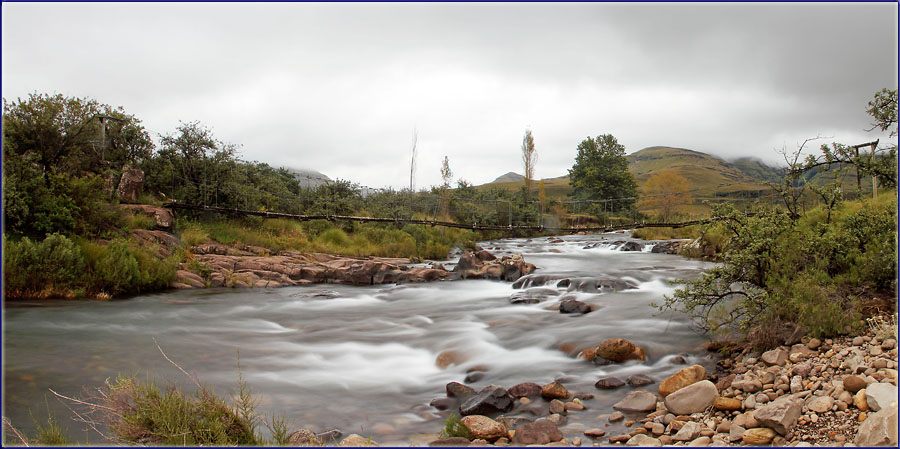
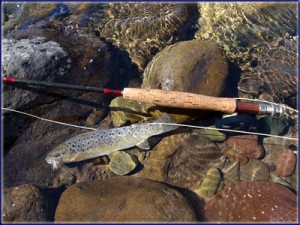
One of the many benefits of fly fishing is the amazing destinations it takes you too. You can end up anywhere from a crystal clear mountain stream to a rocky shoreline unspoiled by humans. There’s something for everyone and the only limitation is your imagination (and budget). Luckily for us in South Africa (and KwaZulu-Natal) some of the most beautiful fly fishing destinations are right here on our doorstep.
This month the Baha Boys take you stream fishing in the Drakensberg and explain how to fish the dry fly with huge success. Few memories come close to that of your first wild trout taken on dry fly.
Sadly, despite the pristine streams available to us in the country, fly fishing is dominated by still-water fishing. Wondering why this was I chatted to several of my fly fishing friends and all of them offered similar explanations. It seemed that they all felt comfortable with still waters and found streams intimidating without knowing where to start. Well here’s how the Baha Boys tackle those streams.
When fishing streams there are two main techniques, namely the nymph and the dry fly. Although nymphing is both hugely successful and popular I turn to the dry fly wherever possible. There’s nothing quite as exhilarating as watching your fly being smashed off the surface of a stream by a wild trout, especially after having meticulously cast it to drift up against an undercut or under an overhanging bush. That said, if the water is deeper or the fish are reluctant to rise to the fly by all means put on a nymph and strike indicator. Or better yet, fish a nymph under a dry fly thereby using it as your indicator.
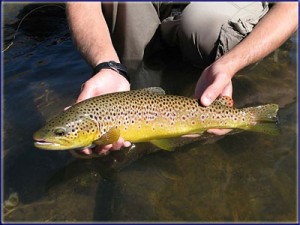
The main mistake made by people who have not previously fished rivers is that they tend to focus on the pools and ignore the water in between. I’d imagine this is mostly due to the fact that the larger pools can be fished in a similar manner to a small still water. Sadly this results in them missing out on the riffles, runs and pocket water located between pools. Although these sections may not always hold the largest fish in the stream, they are certainly the most fun to fish. And when one takes into account that the pools are often scattered with swimming kids and picnicking families, these faster flowing stretches are far too precious to be ignored.
When fishing the runs, riffles and pocket water the Baha Boys tend to fish the upstream, dry fly approach. This involves wading up the stream casting no more than a few meters in front of you and then allowing your fly to drift naturally back towards you, striping in the line merely to pick up the slack and to keep in touch with your fly. Do not strip the fly back towards you; always allow the fly to drift naturally on the water.
The reason we fish upstream is that trout will always (ok generally) point into the current. As a result if you’re wading upstream you are approaching them from behind and are therefore less likely to be seen or to spook them. While wading also be careful not to kick any loose rocks. Sound travels incredibly well underwater and the fish will hear you coming from a mile away.
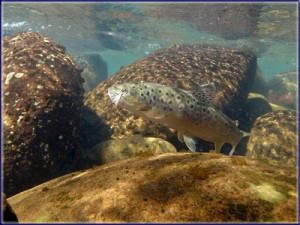
Once cast you should always be able to see your fly and if you can’t it’s definitely worth changing to something more visible. For this reason I usually start with a small white fly as I find them the easiest to spot in the current. Why the need to see the fly? Well although some trout will take the fly fiercely off the surface, thereby alerting you to the take, others will merely sip it from the surface. If you’re not watching your fly you can easily miss these gentle takes and will probably also miss the fish as it spits the fly out rapidly.
Something else to remember is to never rush your fishing. So many people, myself included, tend to rush upstream when they see a likely hold. Generally all this results in is stubbed toes and spooked fish. The hold isn’t going anywhere…approach it carefully, looking for signs of fish, and you’ll be far more likely to produce.
Another common mistake of those new to streams is wanting to cast too far. Not only does this increase the chance of snagging one of the many trees covering the bank, but more importantly, it generally results in one having little control over the drift of the fly due to the current acting on the extra fly line. No self-respecting fish will take a fly from the surface when its heading downstream like a skier being pulled by a power boat. Always try and achieve a natural drift (i.e. your fly should be moving at the same speed, and in the same direction, as the water it’s floating on).
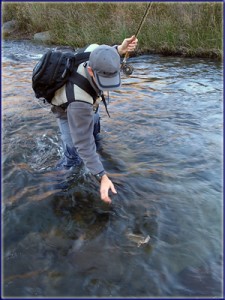
One last tip…think like a fish. Fish look for two things in streams, namely shelter and food. In terms of shelter, fish will often be located under undercuts or below overhanging bushes and trees. Here they are less vulnerable to attacks and feel more comfortable. In terms of food, trout want to get the largest meal with the least effort. They are therefore often located in the slow moving water (where they burn very little energy) directly next to faster moving water (where food is delivered to them quickly and frequently). They can also be found under trees which insects are likely to fall from.
So cast upstream and let your fly drift past that undercut or under those trees. Alternatively cast past a rock, which provides a pocket of slow moving water, and let your fly drift slowly past it. You’ll be amazed by how often you’ll get into a fish as soon as the fly passes the rock. Entries and exits of pools are also prime spots since food is channelled into a smaller area here.
Oh, and remember to fish a lighter tippet than in the dams. We usually start with a 6x tippet and a size 14 fly. And don’t be scared to go smaller if you’re not having any joy.
Stream fishing is all about the take and less about the fight so enjoy the sight of your fly being hammered. Best of luck and we hope to see you on the streams soon. Remember that they close from June through to the end of August so get out there soon.
Until next time, tight lines.
– Warren Prior
